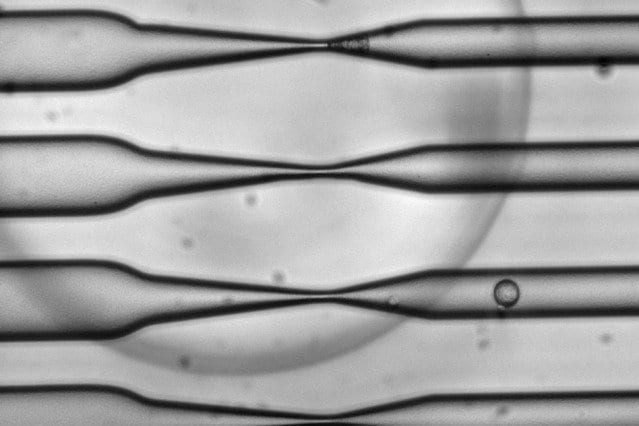
Courtesy of SQZ Biotech
Microfluidic cell-squeezing device opens new possibilities for cell-based vaccines
MIT researchers have shown that they can use a microfluidic cell-squeezing device to introduce specific antigens inside the immune system’s B cells, providing a new approach to developing and implementing antigen-presenting cell vaccines.
Such vaccines, created by reprogramming a patient’s own immune cells to fight invaders, hold great promise for treating cancer and other diseases. However, several inefficiencies have limited their translation to the clinic, and only one therapy has been approved by the Food and Drug Administration.
While most of these vaccines are created with dendritic cells, a class of antigen-presenting cells with broad functionality in the immune system, the researchers demonstrate in a study published in Scientific Reports that B cells can be engineered to serve as an alternative.
“We wanted to remove an important barrier in using B cells as an antigen-presenting cell population, helping them complement or replace dendritic cells,” says Gregory Szeto, a postdoc at MIT’s Koch Institute for Integrative Cancer Research and the paper’s lead author.
Darrell Irvine, a member of the Koch Institute and a professor of biological engineering and of materials sciences and engineering, is the paper’s senior author.
A new vaccine-preparation approach
Dendritic cells are the most naturally versatile antigen-presenting cells. In the body, they continuously sample antigens from potential invaders, which they process and present on their cell surface. The cells then migrate to the spleen or the lymph nodes, where they prime T cells to mount an attack against cells that are cancerous or infected, targeting the specific antigens that are ingested and presented.
Despite their critical role in the immune system, dendritic cells have drawbacks when used for cell-based vaccines: They have a short lifespan, they do not divide when activated, and they are relatively sparse in the bloodstream.
B cells are also antigen-presenting cells, but in contrast to dendritic cells, they can proliferate when activated and are abundant in the bloodstream. However, their functionality is more limited: Whereas dendritic cells constantly sample antigens they encounter, a B cell is genetically programmed only to bind to a specific antigen that matches the receptor on its surface. As such, a B cell generally will not ingest and display an antigen if it does not match its receptor.
Using a microfluidic device, MIT researchers were able to overcome this genetically programmed barrier to antigen uptake — by squeezing the B cells.
Through “CellSqueeze,” the device platform originally developed at MIT, the researchers pass a suspension of B cells and target antigen through tiny, parallel channels etched on a chip. A positive-pressure system moves the suspension through these channels, which gradually narrow, applying a gentle pressure to the B cells. This “squeeze” opens small, temporary holes in their membranes, allowing the target antigen to enter by diffusion.
This process effectively loads the cells with antigens to prime a response of CD8 — or “killer” — T cells, which can then kill cancer cells or other target cells.
Read more: Freshly squeezed vaccines
The Latest on: Cell-based vaccines
[google_news title=”” keyword=”Cell-based vaccines” num_posts=”10″ blurb_length=”0″ show_thumb=”left”]
via Google News
The Latest on: Cell-based vaccines
- Agathos Biologics aims for ethical solutions in gene therapy, including morally derived vaccineson April 27, 2024 at 5:00 pm
Andrzej Noyszewski and Grace Loegering at work in the Agathos Biologics lab on April 11, 2024. The two scientists say they find their jobs especially satisfying because of the company's focus on good ...
- Man receives world’s first melanoma vaccine — trial underwayon April 26, 2024 at 10:54 am
A trial for the world’s first-ever mRNA cancer vaccine for melanoma is underway in the UK. Melanoma is the deadliest form of skin cancer. Around 100,000 Americans are expected to be diagnosed with ...
- U.K. Tests World-First Personalized Skin Cancer Vaccineon April 26, 2024 at 9:08 am
Customized with genetic information from a patient’s own tumor, vaccines like this could one day be used against lung, kidney, bladder and colon cancer.
- A Vaccine to Fight Antibiotic Resistanceon April 25, 2024 at 2:25 pm
MSU, Harvard Medical School team up to expand vaccine science’s role in the fight against MRSA and other infections ...
- Vaccine breakthrough means no more chasing strainson April 25, 2024 at 11:10 am
Scientists at UC Riverside have devised a vaccine that targets a part of the viral genome that is common to all strains of a given virus.
- GlaxoSmithKline sues Pfizer and BioNTech over Covid-19 vaccine technologyon April 25, 2024 at 9:22 am
GlaxoSmithKline sued Pfizer and BioNTech in Delaware federal court on Thursday, accusing them of infringing GSK patents related to messenger RNA (mRNA) technology in the companies' blockbuster ...
- AstraZeneca CEO says platform deals largely done after M&As in vaccines, radioligand, cell therapyon April 25, 2024 at 8:09 am
After AstraZeneca’s recent acquisitions of various technologies across different therapeutic areas, some investors started to wonder if the British pharma is stretching too thin. | After AstraZeneca’s ...
- Applied DNA Awarded Contract by HDT Bio For Rapid Vaccine Development Programon April 25, 2024 at 5:24 am
Under the terms of the contract, Applied DNA will supply Linea™ DNA IVT templates to HDT Bio for use in conjunction with its LION™ formulated repRNA (self-replicating RNA) vaccination platform. The ...
- A Universal Vaccine Against Any Viral Variant? A New Study Suggests It’s Possibleon April 22, 2024 at 1:37 pm
A universal vaccine would train the body to recognize and eradicate new viral strains, even if they've mutated into nearly unrecognizable forms.
- COVID-19 vaccine-caused “turbo cancer” nonsense just keeps getting more turbochargedon April 22, 2024 at 12:00 am
No matter how implausible it is or how weak the evidence for it is, the myth that COVID vaccines cause "turbo cancer" just won't die. Quite the contrary, alas. Antivaxxers are—dare I say?—turbocha ...
via Bing News










